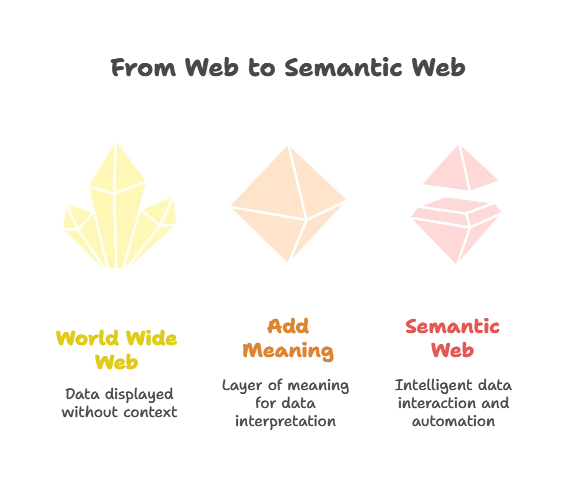XML and the Semantic Web
The Semantic Web aims to make internet data more meaningful, allowing machines to understand and process information more intelligently. XML (eXtensible Markup Language) is fundamental to the Semantic Web, acting as a structure for storing and transporting data. This chapter explores how XML contributes to the Semantic Web, how it interacts with Semantic Web technologies, and provides examples to illustrate these concepts from the basics to advanced applications.
Introduction to the Semantic Web
The Semantic Web, a vision pioneered by Tim Berners-Lee, extends the World Wide Web by adding a layer of meaning, allowing software agents to interpret data contextually rather than merely displaying it. This allows automated systems to interact with data more intelligently and perform actions based on the data’s meaning.

Role of XML in the Semantic Web
XML serves as a flexible data format that is both machine-readable and human-readable. The Semantic Web builds upon XML’s ability to structure complex information, enabling efficient data sharing, linking, and analysis across diverse systems.
Key Functions of XML in the Semantic Web
- Data Structuring: XML organizes data hierarchically, making it ideal for representing complex relationships.
- Data Interchange: As a universal format, XML facilitates interoperability across systems by standardizing data exchange.
- Foundation for Metadata Languages: XML provides the basis for languages like RDF (Resource Description Framework) and OWL (Web Ontology Language), essential to the Semantic Web.
Key Technologies of the Semantic Web
The Semantic Web leverages several technologies, each enhancing data’s semantic meaning and facilitating linked data structures:
- RDF (Resource Description Framework): A framework to describe relationships between data elements.
- OWL (Web Ontology Language): Defines classes and properties, supporting complex relationships.
- SPARQL: A query language for retrieving and manipulating data stored in RDF format
RDF (Resource Description Framework)
RDF represents information as triples (subject-predicate-object), making it a flexible way to express data relationships. Unlike XML’s hierarchical structure, RDF’s triples form a graph structure that links different concepts.
Example of RDF Using XML Serialization
<rdf:RDF xmlns:rdf="http://www.w3.org/1999/02/22-rdf-syntax-ns#">
<rdf:Description rdf:about="http://example.org/book1">
<dc:title xmlns:dc="http://purl.org/dc/elements/1.1/">Introduction to XML</dc:title>
<dc:creator xmlns:dc="http://purl.org/dc/elements/1.1/">John Doe</dc:creator>
<dc:publisher xmlns:dc="http://purl.org/dc/elements/1.1/">Example Publisher</dc:publisher>
</rdf:Description>
</rdf:RDF>
Explanation:
- This RDF document describes a book with a title, author, and publisher.
- The RDF data structure allows this data to be queried and linked to other resources about XML or books.
OWL (Web Ontology Language)
OWL enables the creation of ontologies, which define a domain’s concepts and relationships. This adds a layer of logic, allowing more sophisticated interactions between datasets.
Example of OWL in XML Syntax:
<rdf:RDF xmlns="http://www.w3.org/2002/07/owl#"
xml:base="http://example.org/ontology"
xmlns:rdf="http://www.w3.org/1999/02/22-rdf-syntax-ns#"
xmlns:rdfs="http://www.w3.org/2000/01/rdf-schema#">
<Class rdf:about="http://example.org/ontology/Book"/>
<Class rdf:about="http://example.org/ontology/Author"/>
<ObjectProperty rdf:about="http://example.org/ontology/hasAuthor"/>
</rdf:RDF>
Explanation:
- This ontology defines two classes,
BookandAuthor, and a property,hasAuthor, representing the relationship between a book and its author.
SPARQL and Querying XML-Based Semantic Data
SPARQL is the query language for RDF. It enables querying data with complex relationships in a way that SQL does for relational databases.
Example of a Simple SPARQL Query:
SELECT ?title ?creator
WHERE {
?book dc:title ?title .
?book dc:creator ?creator .
}
Explanation:
- This query retrieves titles and creators from RDF data.
- By applying RDF and SPARQL, systems can query data as interconnected resources rather than isolated datasets.
Integrating XML with RDF and OWL
XML is commonly used for storing and transporting RDF and OWL, acting as a bridge between traditional data systems and Semantic Web technologies.
- XML as RDF Storage: XML-based RDF serialization can store triples directly.
- XML Data Transformation: Transforming XML data into RDF enables XML-based systems to interoperate with RDF-based Semantic Web applications.
Building a Linked Data Ecosystem with XML
Linked Data connects structured data across sources, establishing a web of relationships. XML formats the data, while RDF and OWL define relationships, making it accessible and interconnected.
Code Example of Linking Data with RDF/XML
<rdf:RDF xmlns:rdf="http://www.w3.org/1999/02/22-rdf-syntax-ns#"
xmlns:dc="http://purl.org/dc/elements/1.1/">
<rdf:Description rdf:about="http://example.org/library/book1">
<dc:title>Semantic Web Fundamentals</dc:title>
<dc:creator>Jane Smith</dc:creator>
<dc:related rdf:resource="http://example.org/library/author/JaneSmith"/>
</rdf:Description>
</rdf:RDF>
Explanation:
- This links a book resource with the author resource using the
dc:relatedproperty. - Linking resources with RDF and XML creates interconnected data, forming a Semantic Web.
Advantages and Challenges of XML in the Semantic Web
Advantages:
- Flexibility: XML’s structured data format allows for easy manipulation and compatibility with Semantic Web technologies.
- Interoperability: XML is universally readable, which supports cross-platform data sharing.
- Scalability: XML adapts well to both small and large datasets, making it suitable for varied applications.
Challenges:
- Performance Overhead: XML parsing can be resource-intensive, which might affect performance.
- Complexity: Implementing RDF and OWL in XML structures can add complexity, requiring careful management.
XML is a foundational technology in the Semantic Web, providing the structure needed for data interoperability and intelligent data processing. Through integration with RDF, OWL, and SPARQL, XML-based applications can become part of the broader Semantic Web ecosystem. By understanding these relationships and technologies, developers can build applications that harness the full potential of linked data and Semantic Web architecture, enhancing both data accessibility and interpretability. This completes an A to Z understanding of how XML interacts with the Semantic Web and provides a stepping stone for further exploration and implementation. Happy coding !❤️
